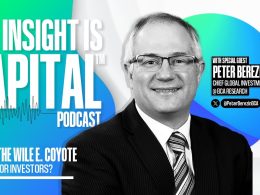by BeiChen Lin, Russell Investments
Executive summary:
- The Bank of Canada and the European Central Bank held overnight rates steady at their March meetings
- Federal Reserve Chair Jerome Powell's testimony to Congress indicates that the U.S. central bank is moving closer to cutting rates
- China announced a 2024 growth target of around 5%
On the latest edition of Market Week in Review, Investment Strategist BeiChen Lin and Product Operations Analyst McKenna Painter discussed recent rate decisions from the Bank of Canada and the European Central Bank. They also examined the state of the U.S. labor market and reviewed the highlights of U.S. Federal Reserve (Fed) Chairman Jerome Powell’s testimony to Congress. Last but not least, they unpacked the latest developments from the Two Sessions meeting in China.
Bank of Canada could start cutting rates by June
Joining from Vancouver, British Columbia, Lin opened the segment with a look at the Bank of Canada (BoC)’s latest decision on interest rates. He said that at the conclusion of its March 6 meeting, the Canadian central bank left its key lending rate unchanged at 5%—a decision that was broadly in line with consensus expectations. However, Lin does expect the BoC to begin cutting rates at some point this year, but whether that occurs in April or June will likely be dependent on how the latest economic data unfolds.
Speaking of data, Lin noted that between now and its next meeting in mid-April, the BoC will receive two monthly job creation reports as well as one inflation report. “The central bank will have a lot of data to work with before it makes its next decision on rates. The bottom line here is that inflation in Canada is coming down, but it’s not down to the BoC’s target range of 2% just yet,” Lin stated, stressing that the BoC wants to be more confident that inflation is heading in the right direction before initiating rate cuts.
A similar story is playing out in Europe, he said, explaining that the European Central Bank (ECB) also held its benchmark interest rate steady at 4% at its March 7 policy meeting. Lin said the bank noted it’s making good progress in taming inflation, and revised its 2024 inflation forecast down from 2.7% to 2.3%. However, like its Canadian counterpart, the ECB wants to ensure that price pressures are continuing to trend lower in the next few months before it begins cutting rates, he said.
“Overall, it does look increasingly likely that the BoC and the ECB—in addition to the U.S. Federal Reserve—will start lowering rates in 2024,” Lin concluded.
Fed’s Powell more confident on downward trajectory of inflation
Turning to the U.S., Lin said the Fed is continuing to bring the labor market—which was extremely overheated in 2022—back into better balance. The U.S. central bank has made notable progress on this end, he remarked, as evidenced by improvements in the quit rate and the ratio of job openings to the number of unemployed workers.
However, the Fed’s work on cooling the labor market isn’t complete just yet, Lin said, which makes the next few jobs reports vital for the central bank as it weighs cutting rates. “Fed officials want the U.S. economy to stay strong—but not too strong. If the economy and labor market are too strong, it’s tougher for the Fed to achieve its objective of bringing inflation back to its 2% target,” he explained.
Lin noted that similar to many other developed markets, the Fed has made a lot of progress in bringing down inflation, with the core personal consumption expenditures (PCE) price index down to 2.5% on a six-month annualized basis. “U.S. inflation is gradually getting closer and closer to the Fed’s 2% target, but it’s not quite there yet,” he stated.
Lin added that Fed Chair Jerome Powell testified before Congress the week of March 4, reiterating that the Fed wants to be very confident that inflation is on a sustained downward trajectory before it begins cutting rates. “Powell said the Fed is growing more and more confident that this is the case, and that he expects to reach a point later this year when it will likely be appropriate to start cutting rates,” Lin remarked, stressing that the exact timing will be data-dependent.
China sets 5% growth target for 2024
Painter and Lin wrapped up the segment by unpacking the key announcements from China’s recently concluded Two Sessions meeting, which Lin said is one of the big parliamentary meetings held each year. Lin said the main takeaway was that China announced a gross domestic product (GDP) growth target of around 5% for 2024—matching the growth target the country set in 2023.
However, one key difference between last year’s growth target and this year’s is that achieving a year-over-year growth rate of 5% in 2023 was easier, since that rate was calculated by comparing 2023 growth to 2022 growth—and 2022 was a year when economic activity in China was relatively subdued, Lin explained. “This year, it’s going to be harder for China to meet a 5% growth target, since 2024’s growth rate will be in comparison to 2023’s solid growth rate. From my perspective, in order to meet this year’s target, the Chinese government will need to provide more stimulus,” he stated.
Lin said this has already been happening to some extent this year, with China announcing more and more piecemeal stimulus measures over the past few months. One instance occurred at the Two Sessions meeting, where leaders announced the issuance of more bonds from the central government to try to take some of the load off local governments, he remarked. “This was a step in the right direction, but I believe more significant stimulus is needed,” Lin stated, adding that he thinks China will deliver some additional stimulus as the year progresses.
Copyright © Russell Investments















